Change Management Consultation Report for Manufacturing Company
VerifiedAdded on 2020/05/01
|20
|3672
|76
Report
AI Summary
This report provides a comprehensive change management consultation for a manufacturing company. It begins by identifying required changes in leadership style, particularly focusing on Fielder's contingency model to adapt to global expansion. The report then differentiates between traditional and learning organizations, exploring Woolner's 5-stage model and Senge's 5 disciplines, concluding that the company is in the second stage of Woolner's model due to lack of investment in training and outdated processes. The consultation further analyzes Balogun and Hope-Hailey's model, recommending a transformational change approach. The Action Research Model is proposed to address productivity issues, followed by a discussion of proactive innovation strategies. Finally, the report outlines the application of Kotter's 8-step model, specifically focusing on creating urgency. The report emphasizes the need for a shift from a traditional to a learning organization to ensure long-term growth and adaptability.
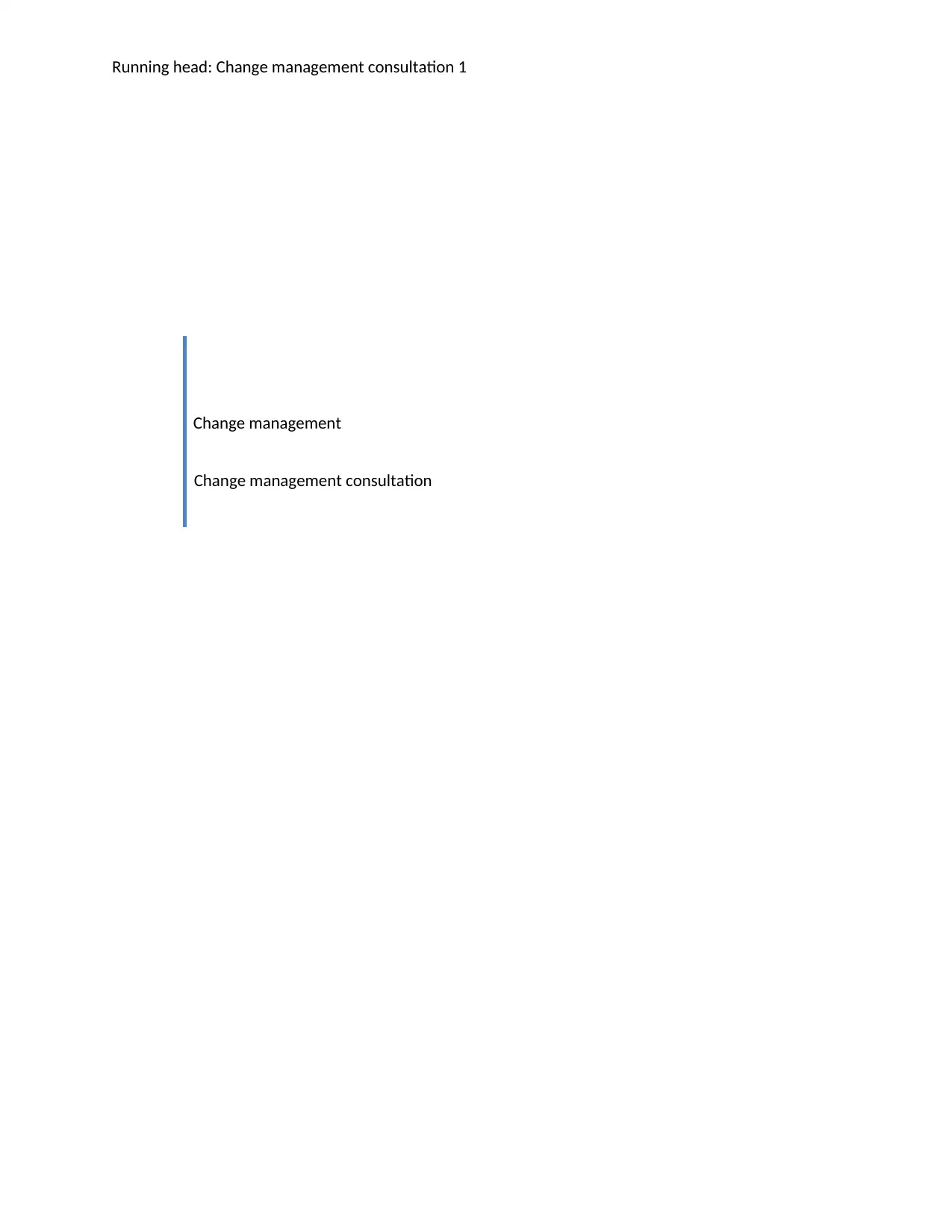
Running head: Change management consultation 1
Change management
Change management consultation
Change management
Change management consultation
Paraphrase This Document
Need a fresh take? Get an instant paraphrase of this document with our AI Paraphraser
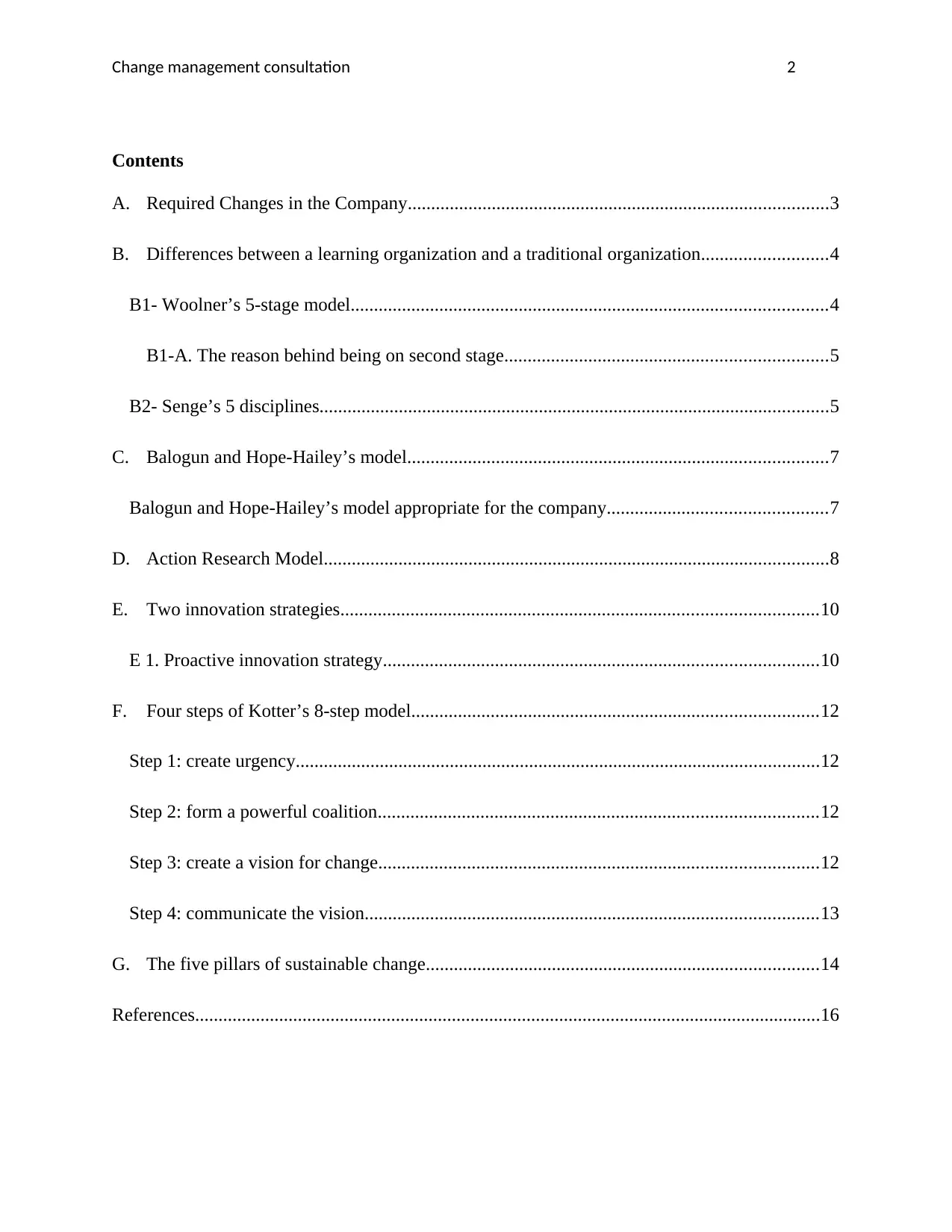
Change management consultation 2
Contents
A. Required Changes in the Company..........................................................................................3
B. Differences between a learning organization and a traditional organization...........................4
B1- Woolner’s 5-stage model......................................................................................................4
B1-A. The reason behind being on second stage.....................................................................5
B2- Senge’s 5 disciplines.............................................................................................................5
C. Balogun and Hope-Hailey’s model..........................................................................................7
Balogun and Hope-Hailey’s model appropriate for the company...............................................7
D. Action Research Model............................................................................................................8
E. Two innovation strategies......................................................................................................10
E 1. Proactive innovation strategy.............................................................................................10
F. Four steps of Kotter’s 8-step model.......................................................................................12
Step 1: create urgency................................................................................................................12
Step 2: form a powerful coalition..............................................................................................12
Step 3: create a vision for change..............................................................................................12
Step 4: communicate the vision.................................................................................................13
G. The five pillars of sustainable change....................................................................................14
References......................................................................................................................................16
Contents
A. Required Changes in the Company..........................................................................................3
B. Differences between a learning organization and a traditional organization...........................4
B1- Woolner’s 5-stage model......................................................................................................4
B1-A. The reason behind being on second stage.....................................................................5
B2- Senge’s 5 disciplines.............................................................................................................5
C. Balogun and Hope-Hailey’s model..........................................................................................7
Balogun and Hope-Hailey’s model appropriate for the company...............................................7
D. Action Research Model............................................................................................................8
E. Two innovation strategies......................................................................................................10
E 1. Proactive innovation strategy.............................................................................................10
F. Four steps of Kotter’s 8-step model.......................................................................................12
Step 1: create urgency................................................................................................................12
Step 2: form a powerful coalition..............................................................................................12
Step 3: create a vision for change..............................................................................................12
Step 4: communicate the vision.................................................................................................13
G. The five pillars of sustainable change....................................................................................14
References......................................................................................................................................16
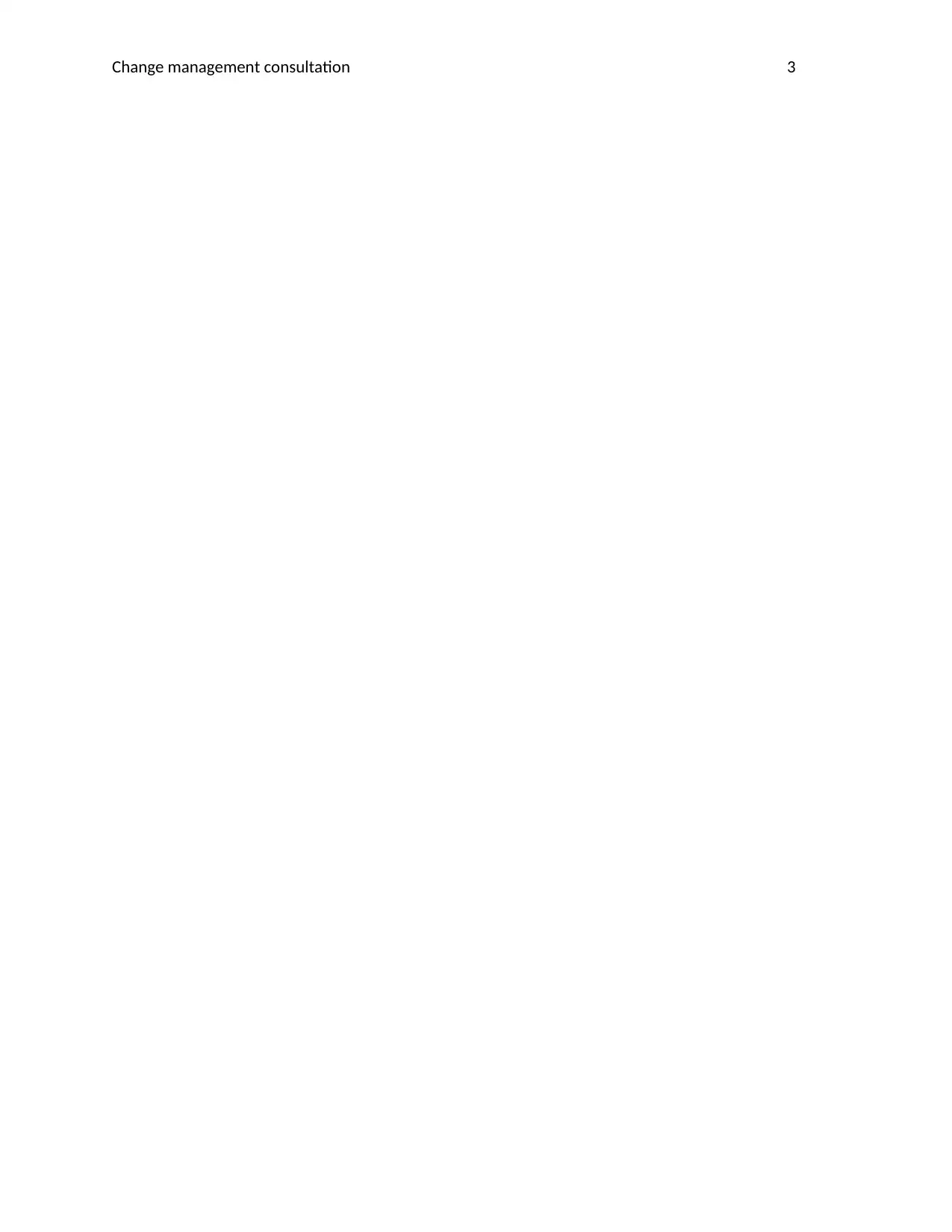
Change management consultation 3
⊘ This is a preview!⊘
Do you want full access?
Subscribe today to unlock all pages.

Trusted by 1+ million students worldwide
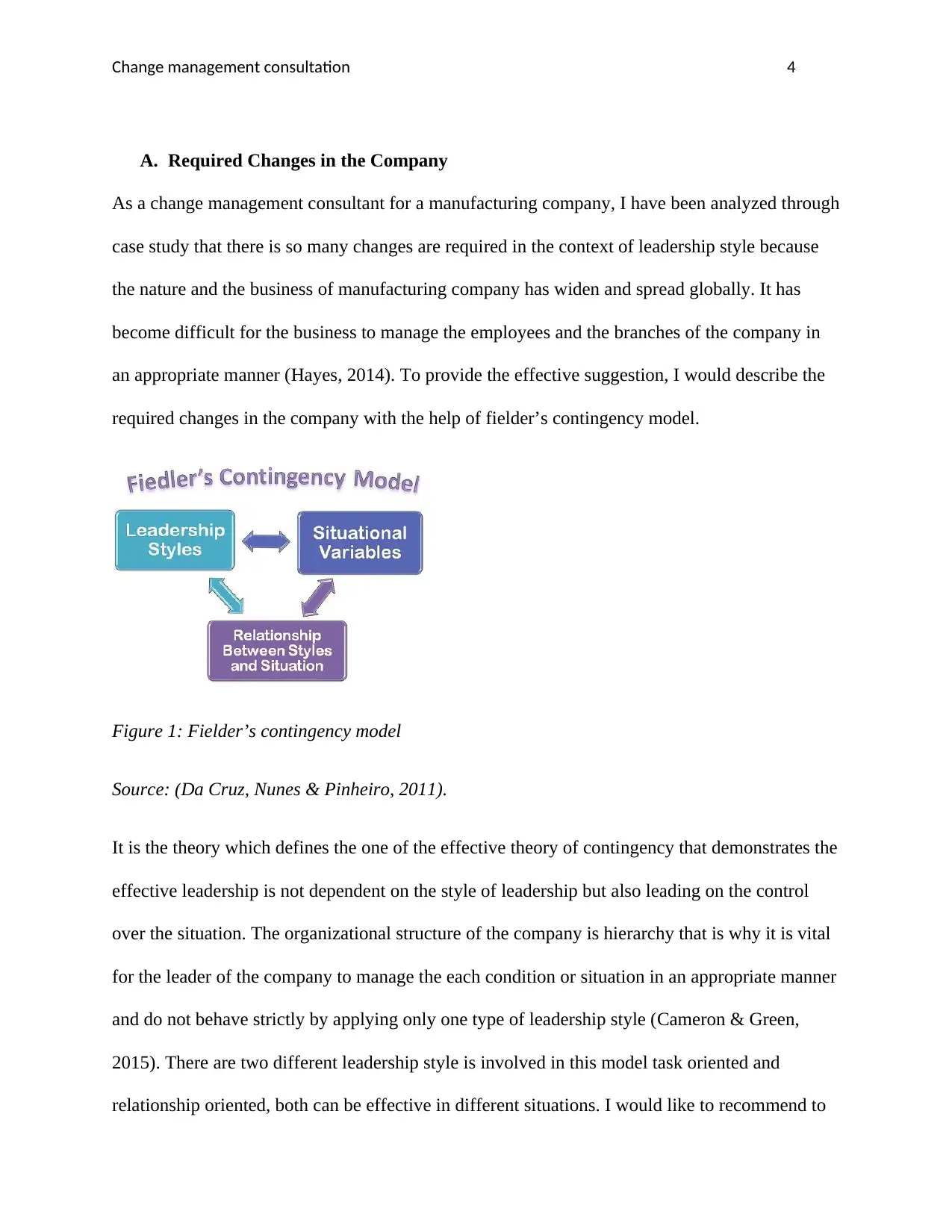
Change management consultation 4
A. Required Changes in the Company
As a change management consultant for a manufacturing company, I have been analyzed through
case study that there is so many changes are required in the context of leadership style because
the nature and the business of manufacturing company has widen and spread globally. It has
become difficult for the business to manage the employees and the branches of the company in
an appropriate manner (Hayes, 2014). To provide the effective suggestion, I would describe the
required changes in the company with the help of fielder’s contingency model.
Figure 1: Fielder’s contingency model
Source: (Da Cruz, Nunes & Pinheiro, 2011).
It is the theory which defines the one of the effective theory of contingency that demonstrates the
effective leadership is not dependent on the style of leadership but also leading on the control
over the situation. The organizational structure of the company is hierarchy that is why it is vital
for the leader of the company to manage the each condition or situation in an appropriate manner
and do not behave strictly by applying only one type of leadership style (Cameron & Green,
2015). There are two different leadership style is involved in this model task oriented and
relationship oriented, both can be effective in different situations. I would like to recommend to
A. Required Changes in the Company
As a change management consultant for a manufacturing company, I have been analyzed through
case study that there is so many changes are required in the context of leadership style because
the nature and the business of manufacturing company has widen and spread globally. It has
become difficult for the business to manage the employees and the branches of the company in
an appropriate manner (Hayes, 2014). To provide the effective suggestion, I would describe the
required changes in the company with the help of fielder’s contingency model.
Figure 1: Fielder’s contingency model
Source: (Da Cruz, Nunes & Pinheiro, 2011).
It is the theory which defines the one of the effective theory of contingency that demonstrates the
effective leadership is not dependent on the style of leadership but also leading on the control
over the situation. The organizational structure of the company is hierarchy that is why it is vital
for the leader of the company to manage the each condition or situation in an appropriate manner
and do not behave strictly by applying only one type of leadership style (Cameron & Green,
2015). There are two different leadership style is involved in this model task oriented and
relationship oriented, both can be effective in different situations. I would like to recommend to
Paraphrase This Document
Need a fresh take? Get an instant paraphrase of this document with our AI Paraphraser
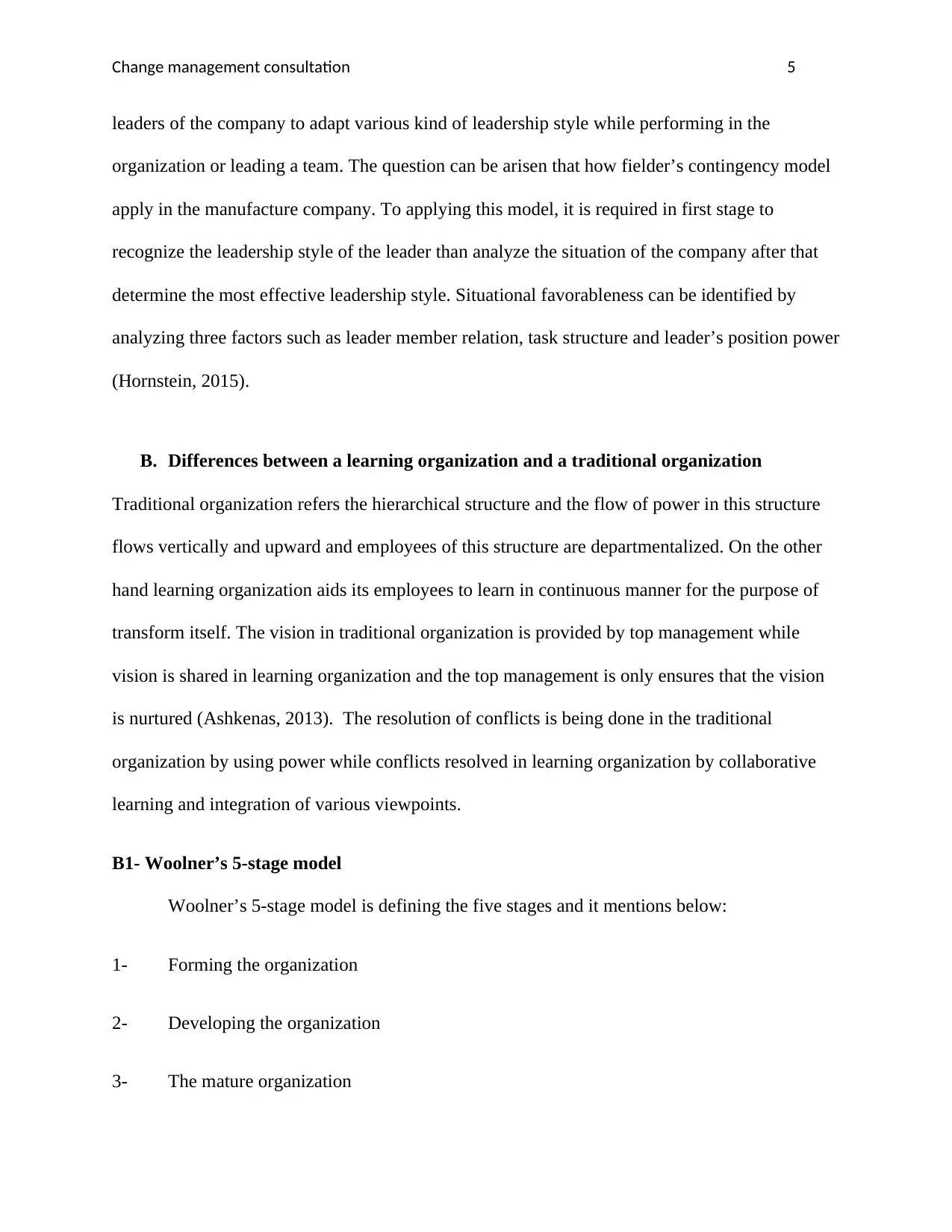
Change management consultation 5
leaders of the company to adapt various kind of leadership style while performing in the
organization or leading a team. The question can be arisen that how fielder’s contingency model
apply in the manufacture company. To applying this model, it is required in first stage to
recognize the leadership style of the leader than analyze the situation of the company after that
determine the most effective leadership style. Situational favorableness can be identified by
analyzing three factors such as leader member relation, task structure and leader’s position power
(Hornstein, 2015).
B. Differences between a learning organization and a traditional organization
Traditional organization refers the hierarchical structure and the flow of power in this structure
flows vertically and upward and employees of this structure are departmentalized. On the other
hand learning organization aids its employees to learn in continuous manner for the purpose of
transform itself. The vision in traditional organization is provided by top management while
vision is shared in learning organization and the top management is only ensures that the vision
is nurtured (Ashkenas, 2013). The resolution of conflicts is being done in the traditional
organization by using power while conflicts resolved in learning organization by collaborative
learning and integration of various viewpoints.
B1- Woolner’s 5-stage model
Woolner’s 5-stage model is defining the five stages and it mentions below:
1- Forming the organization
2- Developing the organization
3- The mature organization
leaders of the company to adapt various kind of leadership style while performing in the
organization or leading a team. The question can be arisen that how fielder’s contingency model
apply in the manufacture company. To applying this model, it is required in first stage to
recognize the leadership style of the leader than analyze the situation of the company after that
determine the most effective leadership style. Situational favorableness can be identified by
analyzing three factors such as leader member relation, task structure and leader’s position power
(Hornstein, 2015).
B. Differences between a learning organization and a traditional organization
Traditional organization refers the hierarchical structure and the flow of power in this structure
flows vertically and upward and employees of this structure are departmentalized. On the other
hand learning organization aids its employees to learn in continuous manner for the purpose of
transform itself. The vision in traditional organization is provided by top management while
vision is shared in learning organization and the top management is only ensures that the vision
is nurtured (Ashkenas, 2013). The resolution of conflicts is being done in the traditional
organization by using power while conflicts resolved in learning organization by collaborative
learning and integration of various viewpoints.
B1- Woolner’s 5-stage model
Woolner’s 5-stage model is defining the five stages and it mentions below:
1- Forming the organization
2- Developing the organization
3- The mature organization
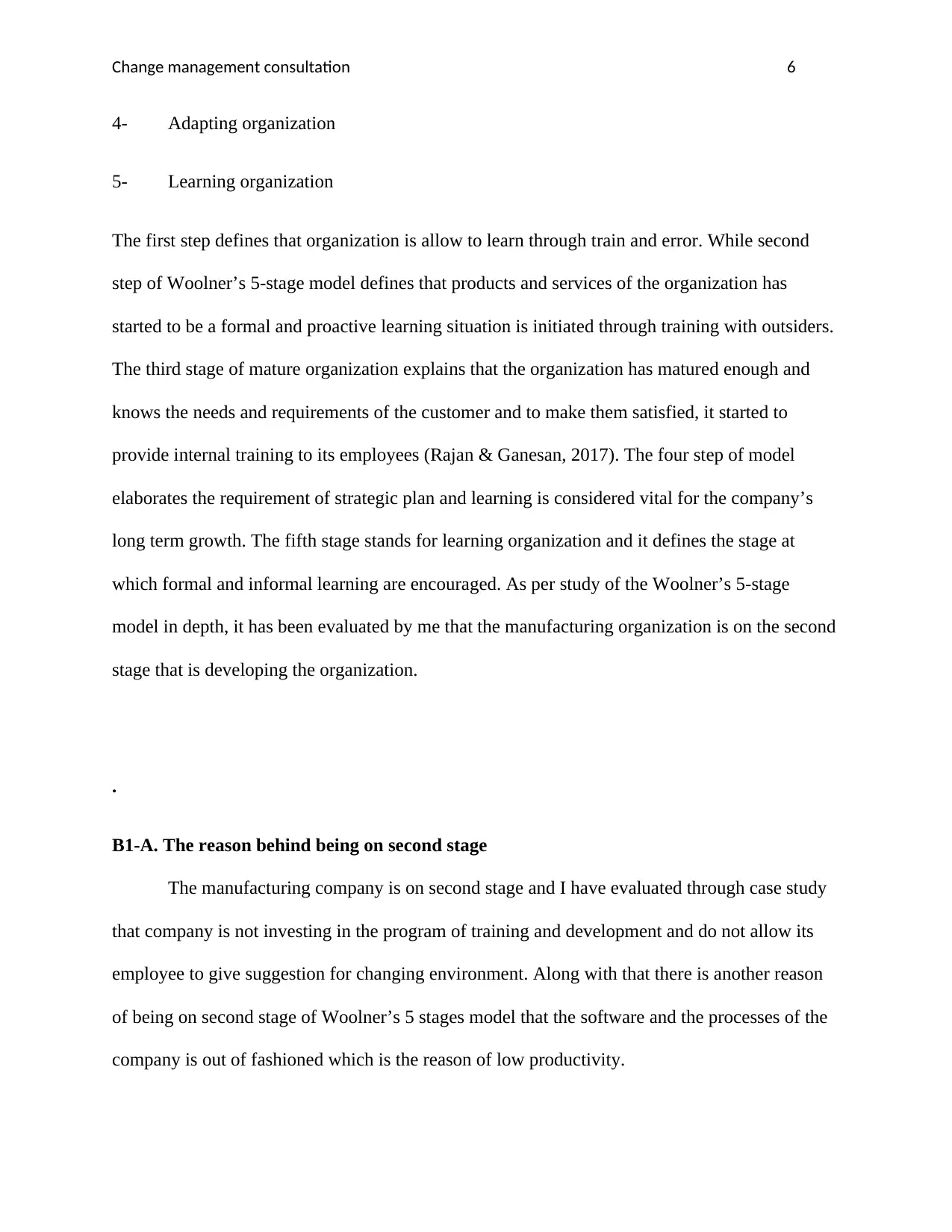
Change management consultation 6
4- Adapting organization
5- Learning organization
The first step defines that organization is allow to learn through train and error. While second
step of Woolner’s 5-stage model defines that products and services of the organization has
started to be a formal and proactive learning situation is initiated through training with outsiders.
The third stage of mature organization explains that the organization has matured enough and
knows the needs and requirements of the customer and to make them satisfied, it started to
provide internal training to its employees (Rajan & Ganesan, 2017). The four step of model
elaborates the requirement of strategic plan and learning is considered vital for the company’s
long term growth. The fifth stage stands for learning organization and it defines the stage at
which formal and informal learning are encouraged. As per study of the Woolner’s 5-stage
model in depth, it has been evaluated by me that the manufacturing organization is on the second
stage that is developing the organization.
.
B1-A. The reason behind being on second stage
The manufacturing company is on second stage and I have evaluated through case study
that company is not investing in the program of training and development and do not allow its
employee to give suggestion for changing environment. Along with that there is another reason
of being on second stage of Woolner’s 5 stages model that the software and the processes of the
company is out of fashioned which is the reason of low productivity.
4- Adapting organization
5- Learning organization
The first step defines that organization is allow to learn through train and error. While second
step of Woolner’s 5-stage model defines that products and services of the organization has
started to be a formal and proactive learning situation is initiated through training with outsiders.
The third stage of mature organization explains that the organization has matured enough and
knows the needs and requirements of the customer and to make them satisfied, it started to
provide internal training to its employees (Rajan & Ganesan, 2017). The four step of model
elaborates the requirement of strategic plan and learning is considered vital for the company’s
long term growth. The fifth stage stands for learning organization and it defines the stage at
which formal and informal learning are encouraged. As per study of the Woolner’s 5-stage
model in depth, it has been evaluated by me that the manufacturing organization is on the second
stage that is developing the organization.
.
B1-A. The reason behind being on second stage
The manufacturing company is on second stage and I have evaluated through case study
that company is not investing in the program of training and development and do not allow its
employee to give suggestion for changing environment. Along with that there is another reason
of being on second stage of Woolner’s 5 stages model that the software and the processes of the
company is out of fashioned which is the reason of low productivity.
⊘ This is a preview!⊘
Do you want full access?
Subscribe today to unlock all pages.

Trusted by 1+ million students worldwide
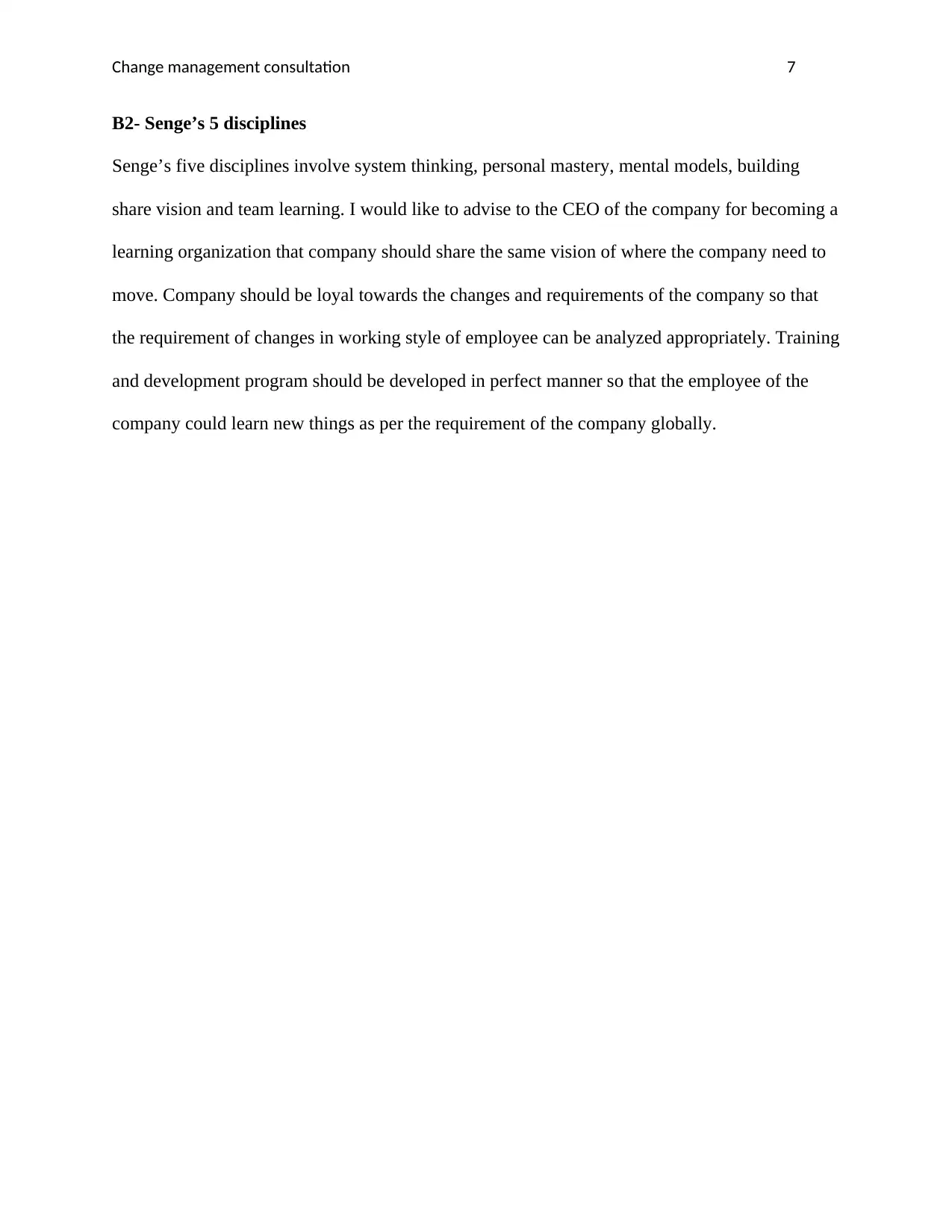
Change management consultation 7
B2- Senge’s 5 disciplines
Senge’s five disciplines involve system thinking, personal mastery, mental models, building
share vision and team learning. I would like to advise to the CEO of the company for becoming a
learning organization that company should share the same vision of where the company need to
move. Company should be loyal towards the changes and requirements of the company so that
the requirement of changes in working style of employee can be analyzed appropriately. Training
and development program should be developed in perfect manner so that the employee of the
company could learn new things as per the requirement of the company globally.
B2- Senge’s 5 disciplines
Senge’s five disciplines involve system thinking, personal mastery, mental models, building
share vision and team learning. I would like to advise to the CEO of the company for becoming a
learning organization that company should share the same vision of where the company need to
move. Company should be loyal towards the changes and requirements of the company so that
the requirement of changes in working style of employee can be analyzed appropriately. Training
and development program should be developed in perfect manner so that the employee of the
company could learn new things as per the requirement of the company globally.
Paraphrase This Document
Need a fresh take? Get an instant paraphrase of this document with our AI Paraphraser
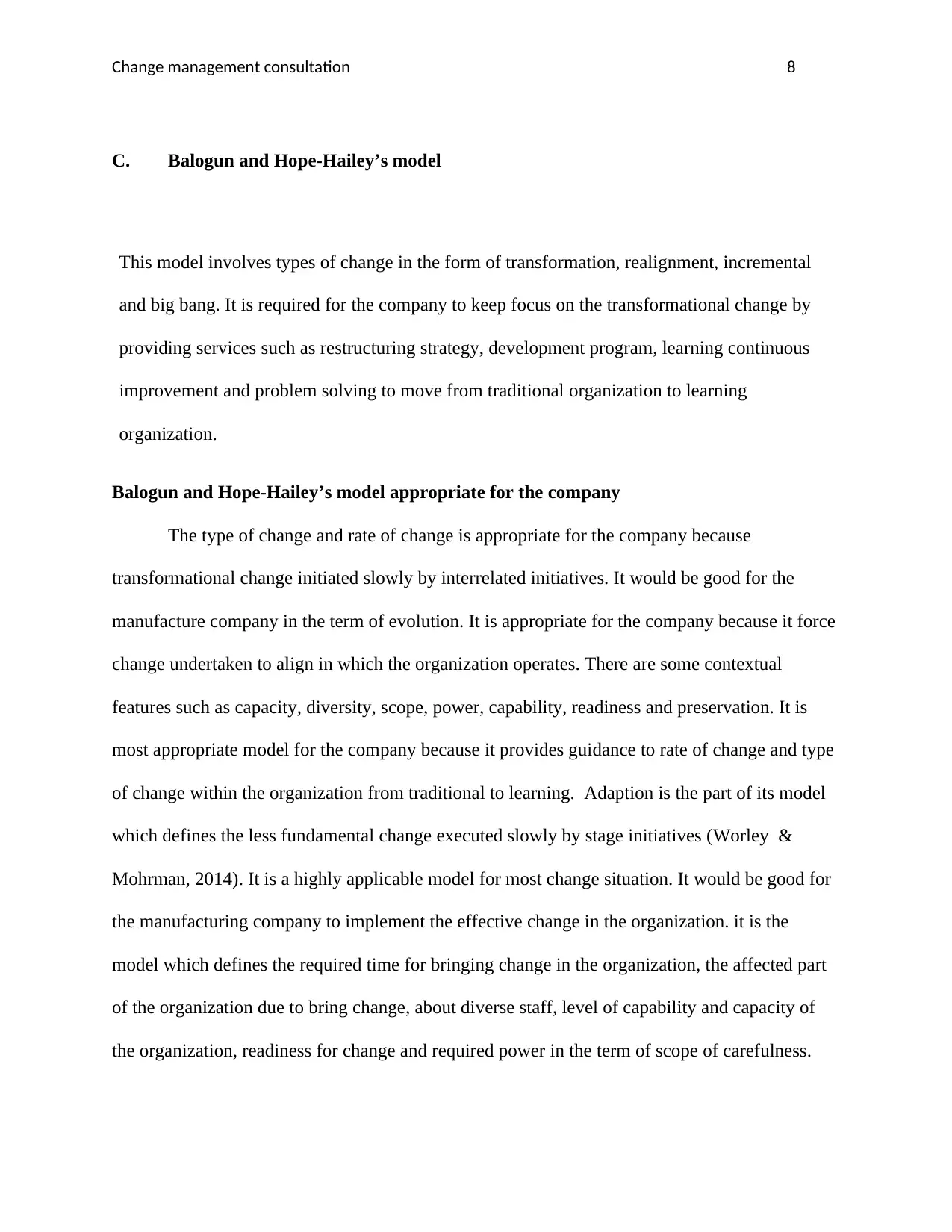
Change management consultation 8
C. Balogun and Hope-Hailey’s model
This model involves types of change in the form of transformation, realignment, incremental
and big bang. It is required for the company to keep focus on the transformational change by
providing services such as restructuring strategy, development program, learning continuous
improvement and problem solving to move from traditional organization to learning
organization.
Balogun and Hope-Hailey’s model appropriate for the company
The type of change and rate of change is appropriate for the company because
transformational change initiated slowly by interrelated initiatives. It would be good for the
manufacture company in the term of evolution. It is appropriate for the company because it force
change undertaken to align in which the organization operates. There are some contextual
features such as capacity, diversity, scope, power, capability, readiness and preservation. It is
most appropriate model for the company because it provides guidance to rate of change and type
of change within the organization from traditional to learning. Adaption is the part of its model
which defines the less fundamental change executed slowly by stage initiatives (Worley &
Mohrman, 2014). It is a highly applicable model for most change situation. It would be good for
the manufacturing company to implement the effective change in the organization. it is the
model which defines the required time for bringing change in the organization, the affected part
of the organization due to bring change, about diverse staff, level of capability and capacity of
the organization, readiness for change and required power in the term of scope of carefulness.
C. Balogun and Hope-Hailey’s model
This model involves types of change in the form of transformation, realignment, incremental
and big bang. It is required for the company to keep focus on the transformational change by
providing services such as restructuring strategy, development program, learning continuous
improvement and problem solving to move from traditional organization to learning
organization.
Balogun and Hope-Hailey’s model appropriate for the company
The type of change and rate of change is appropriate for the company because
transformational change initiated slowly by interrelated initiatives. It would be good for the
manufacture company in the term of evolution. It is appropriate for the company because it force
change undertaken to align in which the organization operates. There are some contextual
features such as capacity, diversity, scope, power, capability, readiness and preservation. It is
most appropriate model for the company because it provides guidance to rate of change and type
of change within the organization from traditional to learning. Adaption is the part of its model
which defines the less fundamental change executed slowly by stage initiatives (Worley &
Mohrman, 2014). It is a highly applicable model for most change situation. It would be good for
the manufacturing company to implement the effective change in the organization. it is the
model which defines the required time for bringing change in the organization, the affected part
of the organization due to bring change, about diverse staff, level of capability and capacity of
the organization, readiness for change and required power in the term of scope of carefulness.
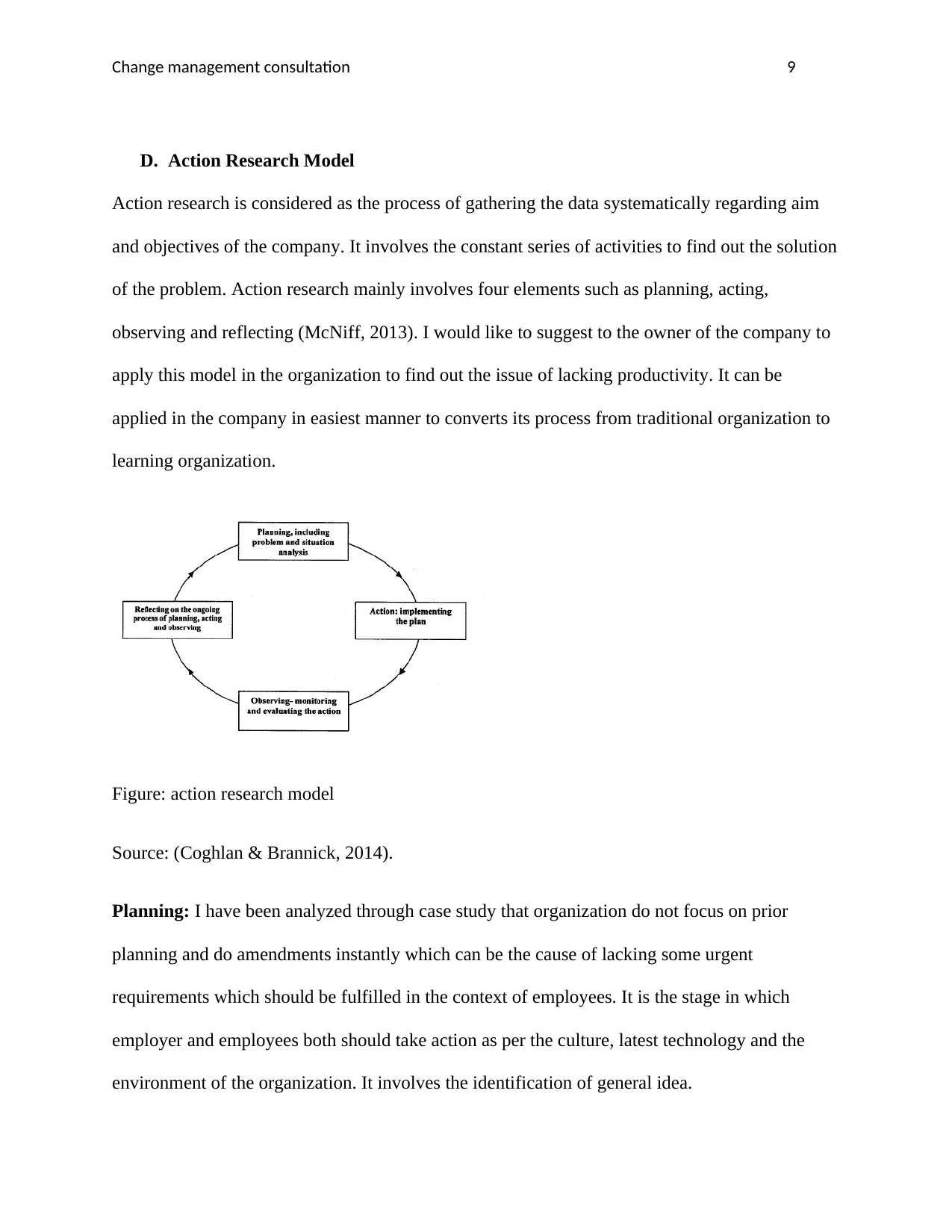
Change management consultation 9
D. Action Research Model
Action research is considered as the process of gathering the data systematically regarding aim
and objectives of the company. It involves the constant series of activities to find out the solution
of the problem. Action research mainly involves four elements such as planning, acting,
observing and reflecting (McNiff, 2013). I would like to suggest to the owner of the company to
apply this model in the organization to find out the issue of lacking productivity. It can be
applied in the company in easiest manner to converts its process from traditional organization to
learning organization.
Figure: action research model
Source: (Coghlan & Brannick, 2014).
Planning: I have been analyzed through case study that organization do not focus on prior
planning and do amendments instantly which can be the cause of lacking some urgent
requirements which should be fulfilled in the context of employees. It is the stage in which
employer and employees both should take action as per the culture, latest technology and the
environment of the organization. It involves the identification of general idea.
D. Action Research Model
Action research is considered as the process of gathering the data systematically regarding aim
and objectives of the company. It involves the constant series of activities to find out the solution
of the problem. Action research mainly involves four elements such as planning, acting,
observing and reflecting (McNiff, 2013). I would like to suggest to the owner of the company to
apply this model in the organization to find out the issue of lacking productivity. It can be
applied in the company in easiest manner to converts its process from traditional organization to
learning organization.
Figure: action research model
Source: (Coghlan & Brannick, 2014).
Planning: I have been analyzed through case study that organization do not focus on prior
planning and do amendments instantly which can be the cause of lacking some urgent
requirements which should be fulfilled in the context of employees. It is the stage in which
employer and employees both should take action as per the culture, latest technology and the
environment of the organization. It involves the identification of general idea.
⊘ This is a preview!⊘
Do you want full access?
Subscribe today to unlock all pages.

Trusted by 1+ million students worldwide
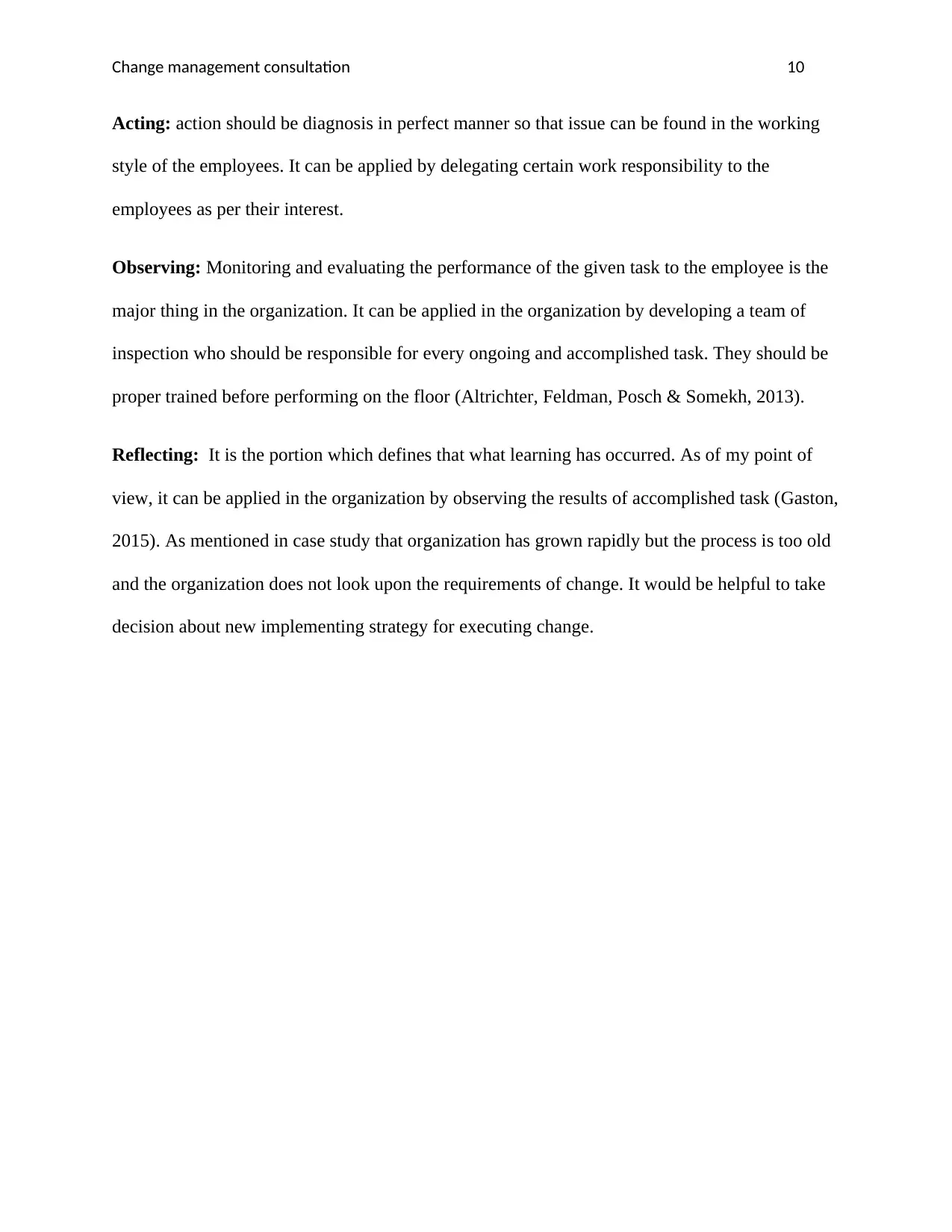
Change management consultation 10
Acting: action should be diagnosis in perfect manner so that issue can be found in the working
style of the employees. It can be applied by delegating certain work responsibility to the
employees as per their interest.
Observing: Monitoring and evaluating the performance of the given task to the employee is the
major thing in the organization. It can be applied in the organization by developing a team of
inspection who should be responsible for every ongoing and accomplished task. They should be
proper trained before performing on the floor (Altrichter, Feldman, Posch & Somekh, 2013).
Reflecting: It is the portion which defines that what learning has occurred. As of my point of
view, it can be applied in the organization by observing the results of accomplished task (Gaston,
2015). As mentioned in case study that organization has grown rapidly but the process is too old
and the organization does not look upon the requirements of change. It would be helpful to take
decision about new implementing strategy for executing change.
Acting: action should be diagnosis in perfect manner so that issue can be found in the working
style of the employees. It can be applied by delegating certain work responsibility to the
employees as per their interest.
Observing: Monitoring and evaluating the performance of the given task to the employee is the
major thing in the organization. It can be applied in the organization by developing a team of
inspection who should be responsible for every ongoing and accomplished task. They should be
proper trained before performing on the floor (Altrichter, Feldman, Posch & Somekh, 2013).
Reflecting: It is the portion which defines that what learning has occurred. As of my point of
view, it can be applied in the organization by observing the results of accomplished task (Gaston,
2015). As mentioned in case study that organization has grown rapidly but the process is too old
and the organization does not look upon the requirements of change. It would be helpful to take
decision about new implementing strategy for executing change.
Paraphrase This Document
Need a fresh take? Get an instant paraphrase of this document with our AI Paraphraser
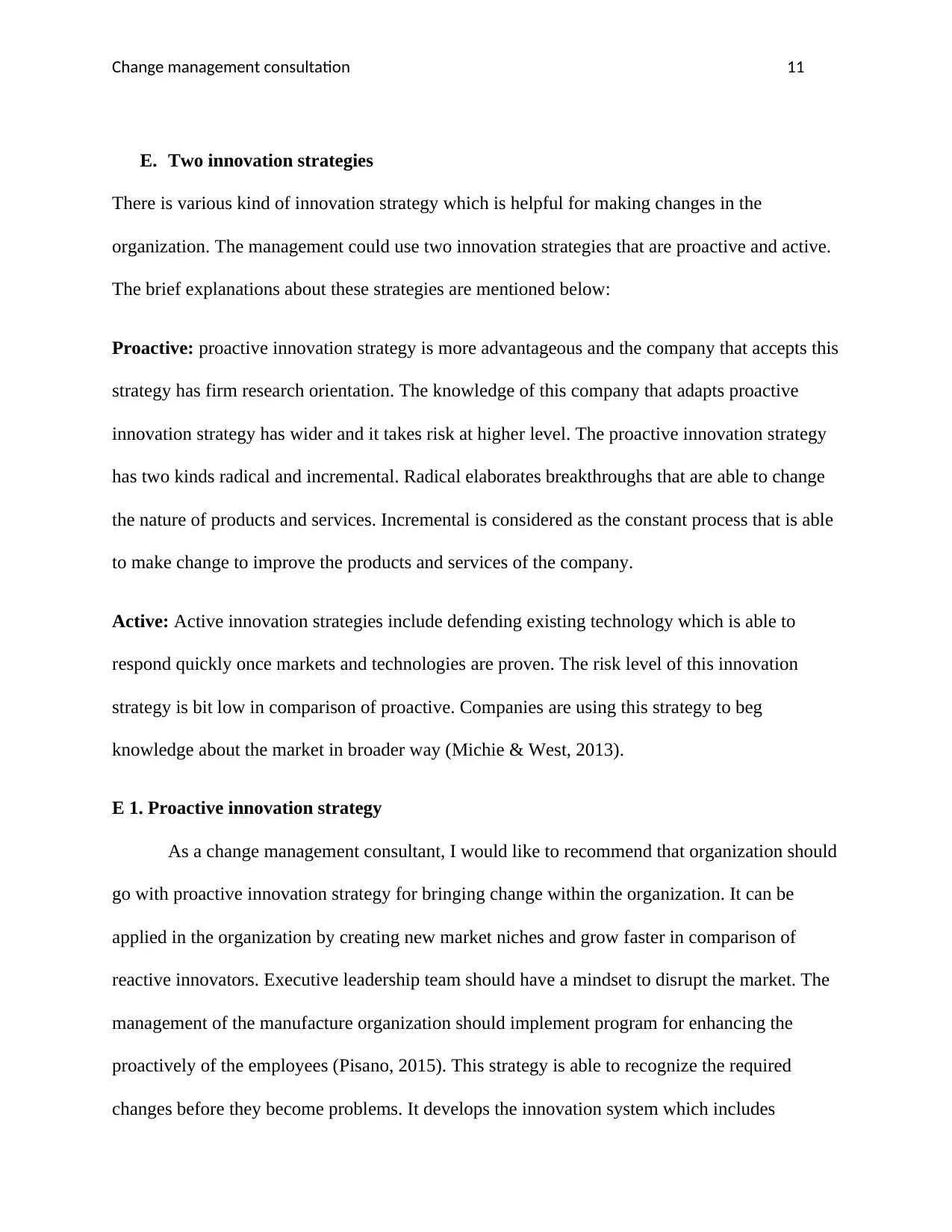
Change management consultation 11
E. Two innovation strategies
There is various kind of innovation strategy which is helpful for making changes in the
organization. The management could use two innovation strategies that are proactive and active.
The brief explanations about these strategies are mentioned below:
Proactive: proactive innovation strategy is more advantageous and the company that accepts this
strategy has firm research orientation. The knowledge of this company that adapts proactive
innovation strategy has wider and it takes risk at higher level. The proactive innovation strategy
has two kinds radical and incremental. Radical elaborates breakthroughs that are able to change
the nature of products and services. Incremental is considered as the constant process that is able
to make change to improve the products and services of the company.
Active: Active innovation strategies include defending existing technology which is able to
respond quickly once markets and technologies are proven. The risk level of this innovation
strategy is bit low in comparison of proactive. Companies are using this strategy to beg
knowledge about the market in broader way (Michie & West, 2013).
E 1. Proactive innovation strategy
As a change management consultant, I would like to recommend that organization should
go with proactive innovation strategy for bringing change within the organization. It can be
applied in the organization by creating new market niches and grow faster in comparison of
reactive innovators. Executive leadership team should have a mindset to disrupt the market. The
management of the manufacture organization should implement program for enhancing the
proactively of the employees (Pisano, 2015). This strategy is able to recognize the required
changes before they become problems. It develops the innovation system which includes
E. Two innovation strategies
There is various kind of innovation strategy which is helpful for making changes in the
organization. The management could use two innovation strategies that are proactive and active.
The brief explanations about these strategies are mentioned below:
Proactive: proactive innovation strategy is more advantageous and the company that accepts this
strategy has firm research orientation. The knowledge of this company that adapts proactive
innovation strategy has wider and it takes risk at higher level. The proactive innovation strategy
has two kinds radical and incremental. Radical elaborates breakthroughs that are able to change
the nature of products and services. Incremental is considered as the constant process that is able
to make change to improve the products and services of the company.
Active: Active innovation strategies include defending existing technology which is able to
respond quickly once markets and technologies are proven. The risk level of this innovation
strategy is bit low in comparison of proactive. Companies are using this strategy to beg
knowledge about the market in broader way (Michie & West, 2013).
E 1. Proactive innovation strategy
As a change management consultant, I would like to recommend that organization should
go with proactive innovation strategy for bringing change within the organization. It can be
applied in the organization by creating new market niches and grow faster in comparison of
reactive innovators. Executive leadership team should have a mindset to disrupt the market. The
management of the manufacture organization should implement program for enhancing the
proactively of the employees (Pisano, 2015). This strategy is able to recognize the required
changes before they become problems. It develops the innovation system which includes
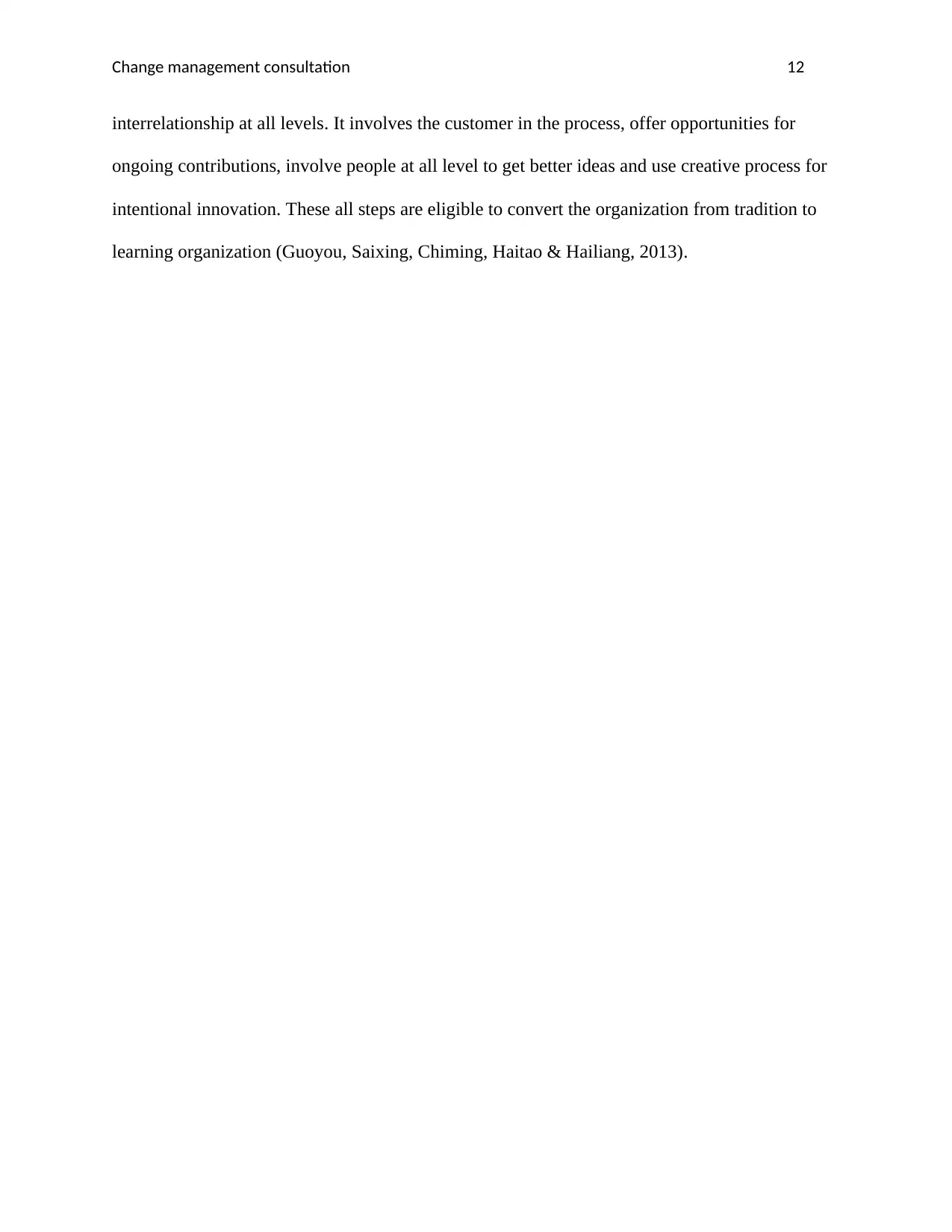
Change management consultation 12
interrelationship at all levels. It involves the customer in the process, offer opportunities for
ongoing contributions, involve people at all level to get better ideas and use creative process for
intentional innovation. These all steps are eligible to convert the organization from tradition to
learning organization (Guoyou, Saixing, Chiming, Haitao & Hailiang, 2013).
interrelationship at all levels. It involves the customer in the process, offer opportunities for
ongoing contributions, involve people at all level to get better ideas and use creative process for
intentional innovation. These all steps are eligible to convert the organization from tradition to
learning organization (Guoyou, Saixing, Chiming, Haitao & Hailiang, 2013).
⊘ This is a preview!⊘
Do you want full access?
Subscribe today to unlock all pages.

Trusted by 1+ million students worldwide
1 out of 20
Related Documents
Your All-in-One AI-Powered Toolkit for Academic Success.
+13062052269
info@desklib.com
Available 24*7 on WhatsApp / Email
![[object Object]](/_next/static/media/star-bottom.7253800d.svg)
Unlock your academic potential
Copyright © 2020–2025 A2Z Services. All Rights Reserved. Developed and managed by ZUCOL.




![Organizational Change Management Report: [University Name] Analysis](/_next/image/?url=https%3A%2F%2Fdesklib.com%2Fmedia%2Forganizational-change-management-hypothetical-company_page_2.jpg&w=256&q=75)
